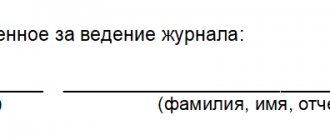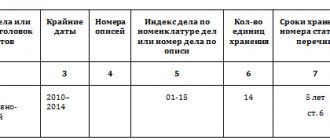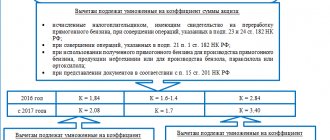What is a private matter?
Private bussiness
– this is the primary document, a folder in which all documents related to work in the organization are collected. There are no established regulations for maintaining personal files of employees at the enterprise, so employees of personnel and accounting services have difficulties.
The folder stores information about all the labor achievements of a particular employee and movements within the enterprise. Copies of orders, statements and other documents that are directly related to a specific person are stored here.
This contains personal information, so the HR employee is obliged to ensure the safety of the information.
An inventory must be kept in each personal file.
Who do they file personal files against?
This question can be answered unequivocally only in relation to civil servants: for all, as required by law.
Since maintaining personal files is not necessary for private entrepreneurs, they themselves can decide which employees to keep this documentation for, and which ones can do without such detailed personnel records. Some managers who practice this system prefer to keep personal records for all personnel in order to systematize data for each employee. But some, in order to save time, organize the management of personal files only for certain categories of employees.
This is also important to know:
Notice of job reduction: sample, procedure for drawing up the document
Personal files are usually opened for employees of what positions:
- management;
- deputy managers at various levels;
- key specialists;
- employees bearing financial responsibility;
- personnel reserve, etc.
FOR YOUR INFORMATION! It is advisable to open a personal file for such employees, regardless of the form and time of his employment - he works part-time or at his main job, under a fixed-term employment contract or on a permanent basis.
Less often, positions are provided with personal records for which educational, qualification or other special requirements are not provided, for example, cleaner, watchman, janitor, etc.
How to create a folder for each employee?
When a new person gets a job, the HR employee must fill out a personal file. Commercial enterprises do not have such an obligation; all data can be stored on a computer. Employees of government agencies financed from the budget are required to create a folder for each.
To create a personal file, you must take the following steps:
- take a blank folder, write “Personal File” on the title page, give it a serial number, indicate the employee’s full name;
- start building a business.
Each document must be kept separately. The personal documents of the newly hired employee are placed in a separate envelope, and they are given a serial number as a separate sheet. Each attachment must be numbered in turn. Documents in the folder should be arranged in chronological order - from admission to dismissal.
For example, the first attachment will be an order for admission to a position with a certain calendar date, and the last attachment will be an order to terminate official relations on a certain calendar date.
What documentation is included in a personal file?
The composition of an employee’s personal folder is not fixed at the legislative level. Each employer independently decides which papers to put in the folder. Conventionally, the documentation stored in the file can be divided into 3 components:
- primary, which is issued upon hiring;
- documents that appear during employment and performance of direct job duties;
- documents specifying the fact of termination of relations with this employer.
The first “branch” includes:
- resume or application form;
- “educational” documents - diplomas, certificates, etc.;
- copies of personal documents - SNILS, TIN, passport;
- a copy of the military ID, if the applicant has one;
- recommendations from the previous employer, if any;
- a certificate stating that the candidate for the position has no criminal record and is not under investigation (required for acceptance to some positions);
- medical examination card;
- an application for employment at this enterprise;
- an order for admission to a specific position from a specific calendar date must contain the signature of the newly hired person indicating familiarization with the document;
- an employment contract signed by both parties to the relationship.
- other papers at the discretion of the enterprise management.
The procedure for creating an employee’s personal file after dismissal
The personal file is closed on the day the person is fired. After this, the authorized specialist must complete it in full:
- check the presence of all documents;
- check the chronology of papers in the folder;
- check the numbering of sheets (all sheets are numbered in Arabic numerals with gross numbering in the upper right corner of the sheet with a simple pencil or numberer).
Then you need to make a final entry on the internal inventory. It indicates the number of sheets included in the LD, as well as the number of sheets of the inventory itself (its sheets should be numbered separately). After which the compiler must sign both the inventory and the final entry. After which you can draw up a so-called certification sheet, which will contain a description of your personal file. Next, all the papers are stitched together: at the beginning of the folder there is an inventory, and at the end there is a certification sheet. On the title page you need to write the closing date in accordance with the dismissal order, as well as the retention period of the entire folder.
Please note that if the dismissed person did not take any original documents, for example, a military ID or medical record, they must be kept until required in his LD. To do this, they should be placed in envelopes (each document separately) and filed in a folder. Such envelopes are numbered, sealed and certified by the signature of an authorized person.
What to do with documentation when a person quits?
A personal file is the primary document of a specific organization; it does not move with the person to places of employment. Therefore, you cannot give it away. A controlling or supervisory authority can check how files are stored, but they do not have access to the information in the folders.
Commercial enterprises do not have a single obligation to maintain personal files for employees. As a rule, folders are created only for management employees. Therefore, each manager independently makes a decision and reflects it in a local act.
The local act also stipulates such nuances as:
- where documents will be stored while a person works at the enterprise;
- storage location after dismissal;
- period of storage in the archive after dismissal.
When a person resigns, the personnel employee is required to close his personal file.
How does closure occur?
You need to close your personal file on the same day that the employment relationship is broken. Calendar dates must match. The responsible personnel employee must adhere to the regulations:
- carefully check the inventory, compare it with the contents of the folder, check the serial numbering;
- close the inventory;
- Attach a separate sheet at the end of the folder - witness;
- stitch and seal the folder;
- on the title page put the calendar date on which he closes the case;
- put away for storage until official archiving;
- upon expiration of the deadline, the case is transferred to the archive.
Must be stored in safes or special locked cabinets. The storage order is by number. If the company is small, then it is possible in alphabetical order or by structural divisions.
If a person worked in a government agency and then quit, his file will be kept in the personnel department for another 10 years. If a dismissed person gets a job again in a government agency, he will be required to indicate his previous place of employment. The responsible employee of the HR department will make a special request about the place of previous work, the personal file will “arrive” after the newly hired one. At the previous place of employment, a corresponding entry will be made in the registration journal.
How many years should it be stored?
As a rule, before archiving, the personal files of dismissed employees are stored in the human resources department.
Commercial firms must keep personal files for 3 years after dismissal, state-owned enterprises - for 10 years after termination of employment.
After this, the documentation is handed over to the archives. Every year, the responsible personnel officer creates an inventory of employees whose employment contract was terminated in the current year. The files of these employees are stored precisely by the date of termination of the employment relationship, and not by the date of opening.
According to Art. 22.1 of Law No. 125-FZ, documents of dismissed employees must be stored in the archives:
- 75 years if the case was closed before 01/01/2003;
- 50 years if the case was closed after 01/01/2003.
The folder may contain papers of different shelf life. The choice by term is determined in favor of a longer time period. After the specified period, the cases are checked for value. If the head of the archive decides to destroy them, the documents are destroyed. It is necessary to fill out an order and inventory. Upon the fact of destruction, a corresponding act is drawn up.
How are the personal files of dismissed employees stored in the archive? They are provided with optimal conditions - humidity, temperature, amount of sunlight and artificial light. This is necessary to ensure that the data is not lost and the ink does not fade.
After the expiration of the storage period at the enterprise, the files of dismissed employees are transferred to the archive. Only government agencies have the right to store such documents.
Retention periods by category of cases and employees
According to Order No. 558, the following storage periods for personal files are established:
- The documentation of those employees who left service before 2003 is kept for 75 years
- 50 years for personal cards of those employees who left their place of work after 2003;
- The personal files of hired personnel who have traveled abroad on a business trip at least once during their career must be kept for 75 years
- Information on the personal income of civil servants, as well as data on their property, must be kept in the archive for 75 years
- CVs and application forms are stored for 5 years
- 75 years old data on rehabilitation issues;
- 3 years of data on those people who, for one reason or another, were denied employment;
- For 75 years they must keep in the archives original copies of documents such as certificates, work books, diplomas, certificates;
- for 5 years - certificates, statements, reports, memos;
- 75 years for acts of acceptance and transfer of personal files of civil servants when transferring them to another job;
- Documents about the subject of personal data - notifications, consents - must be kept in the archives for 75 years
When does the shelf life start?
The temporary period for storing personal files of dismissed employees begins on January 1 of the calendar year following the one in which the official relationship was terminated. So, if a person quits in 2022, then 3 years for storing files at the enterprise will begin from 01/01/2021. The case will need to be transferred to the state archive after 01/01/2024.
Retention period for personal files of dismissed employees
The question often arises, how long are the personal files of dismissed employees kept? LD are long-term storage documents (cases opened after 2003 are stored for 50 years; earlier - 75 years (Article 22.1 of the Federal Law of October 22, 2004 No. 125)), therefore, in the event of an employee’s dismissal, they are subject to careful verification and closure. To do this, all documents in the case are verified, the inventory is closed, a certification sheet is inserted at the end of the case, and then the case is stitched with 4 punctures. How long to keep personal files of dismissed employees?
Archiving of personal files of dismissed employees occurs three years after its closure (for municipal and civil servants this period is 10 years). The records of dismissed employees must be kept separately from the records of existing employees. If the organization has a room for storing archival files, then they are temporarily moved there. If there is no specially equipped room, then they are located either on a separate shelf in the storage room or in another safe.
How to use archival information?
HR employees responsible for storing personal files must ensure that documents are located in a room that is remote from the place of work of the main hired personnel. If a person requires information from a personal file, he must make a formal written request. If the file is kept by the employer, then the document is drawn up in the name of the head of the organization. If the case has already been archived, then the request should be addressed to the head of the archival organization.
At a person's request, they can only provide him with the data that belongs to him. Information about other persons is not disclosed. Only officials can access information about other people as part of investigations. For example, investigation or inquiry workers to establish the truth in a criminal case.
Information from calving frames is provided free of charge. HR employees do not have the right to charge a fee for providing copies of documents from a personal file. Data from the archive can be transferred electronically.
There are certain rules for using archival information:
- legal entities are required to store personal files of dismissed employees for specified periods of time;
- responsible personnel of the HR department are obliged to ensure safe storage on site;
- You can obtain archival information, but only about yourself and only upon an official request - they have no right to refuse, and they also cannot charge a fee for providing copies of documents;
- information from the state archive can be transmitted electronically.
How are files stored in the HR department?
The HR department should only store documents of those employees who are working. They are placed in a special place to which third parties cannot have access, this eliminates the possibility of their loss or theft. As a rule, special safes that are locked with a key are used for storage. All documents are located in a vertical position under a serial number and in alphabetical order. The repository should also contain a list of all personal files.
A separate logbook is kept. As for the general form, it has not been approved, so each organization can develop it independently. According to all the rules, at the end of the working day the presence of papers in the safe must be checked. In case of loss, measures must be taken immediately to return them to their place.
Who has access to archived data?
The head of the enterprise must issue an order in which he gives a list of employees who have access to personal files. Each responsible employee must sign the order.
For state-owned enterprises, the following obligation is prescribed: at least once a year, the responsible employee of the personnel service must familiarize the hired personnel of the organization with the contents of their personal files. After familiarization, you should issue a special card, which indicates the date of familiarization and the personal signature of the civil servant. The introduction card is filed in the personal file.
for commercial enterprises.
Responsibility for personal affairs
The list of employees who have access to personal files is regulated by order of the head of the organization. The employee also has the right to familiarize himself with any information regarding his person, which is kept by the personnel officer.
Access of third parties to personal information is prohibited and is classified as a violation of the legislation of the Russian Federation.
Free legal consultation
We will answer your question in 5 minutes!
Free legal consultation We will answer your question in 5 minutes!
Ask a Question
Ask a Question
According to the current legislation of the Russian Federation, those responsible for violating the inviolability of personal data can be held accountable:
- disciplinary (subparagraph “c”, paragraph 6, part 1, article 81 and article 192 of the Labor Code of the Russian Federation);
- material (clause 7, part 1, article 243 of the Labor Code of the Russian Federation);
- administrative (Articles 13.11 and 13.14 of the Administrative Code of the Russian Federation);
- criminal (Articles 137 and 140 of the Criminal Code of the Russian Federation).
According to Part 2 of Art. 13.11 of the Code of Administrative Offenses of the Russian Federation, working with personal data without written consent entails a fine of 3,000–5,000 rubles. (for citizens) up to 15,000–75,000 rub. (for legal entities).
How to hand over a case?
If necessary, a person can access his file and get it in his hands. The responsible HR employee must document this fact in the registration card. It will contain the following information:
- number of the personal file issued in hand;
- the date on which the issuance occurred;
- Full name of the employee, his position;
- telephone number for contact;
- signature of the employee who took the case;
- the date the case was returned to HR;
- signature of the responsible HR employee confirming the return of the case.
Document storage
At the level of regulations, the required composition of documents in a personal file is not indicated.
This is also important to know:
Issuance of a work book upon dismissal according to the Labor Code of the Russian Federation: when is a work book issued
A strictly approved list is regulated only for employees of public services.
Each enterprise can use this list in its work, and depending on the direction of the enterprise’s activity, determine the need to include a particular document in its personal file.
List of required copies of documents:
- passport (page with photo, registration, marital status);
- diploma, certificate of advanced training;
- SNILS, INN;
- military ID;
- employment history.
Also involved in the matter:
- certificates of passing a medical examination and no criminal record;
- a specialist’s personal application for employment;
- autobiography, employment contract;
- documentation of past certification;
- photographs of workers.
If necessary, the list is subject to adjustment.
Without the personal consent of the employee, it is prohibited to include information about the worker’s personal life, his religious and political views.
Personal files in electronic form
Many Russian enterprises are introducing electronic document management. This applies not only to accounting, but also to personnel records. Using a specialized program, you can conduct personal affairs electronically. Commercial enterprises are not required to make a paper duplicate, but government enterprises are still required.
This is necessary in order to ensure the security of data about government employees. When files are transferred to the state archive, they are digitized and an electronic copy is made.
Accounting and data recording
The accounting procedure must be carried out in accordance with the regulatory act in the labor sphere. Naturally, all changes must be registered in the personnel department and in a certain order. To make it convenient to keep such records, create a special journal. At the time of registration, the following data can be entered: registration number, full name of the employee, date of registration, note of deregistration.
The moment of registration is the date of recording in the registration book. In office work, it is possible to make changes to folders with personal files. Such changes must be recorded at the time of marriage, change of place of residence and upon transfer to another place of work.
In order for changes to be made, the employee must contact the personnel department himself, after which the head of the archive gives the command to enter the data. Data entry should follow the following algorithm:
- The employee must write a statement requesting changes to the documentation. Data can be entered under certain circumstances and their actual confirmation.
- Next, an order is issued that innovations must be included in the accounting documentation.
- The order is recorded in the journal.
- All information is recorded directly.
This is also important to know:
Payroll sheet - sample
Thus, we can conclude that the registration of documents, their storage and disposal of personal data are regulated by law.
conclusions
When dismissing an employee, there are certain rules that must be followed:
- The case must be closed on the day the employment relationship was terminated.
- The employee's file must be transferred to the archive three years after its completion.
- The personnel officer is responsible for storage.
Documents of dismissed employees (all folders and papers) must be stored in a separate room that is inaccessible to third parties. All papers are placed in a safe to prevent loss or theft. A former employee has the right to send a request to the company to provide him with all documents. If the organization has already gotten rid of them by that time, then the manager will be punished under Art. 13.20 Code of Administrative Offenses of the Russian Federation.
Subscribe to the latest news
Additional questions
Can the shelf life of employees be reduced?
The storage period for the personal files of dismissed employees is 50 years. In this case, all changes must be taken into account and entered into folders. There is a special certification sheet, which is located at the end and an inventory sheet at the beginning. The title page indicates the closing date of the case and the period of its storage.
If the employee left original documents, then each such document is placed in a separate envelope and also attached to the file. Each envelope has its own numbering, which is also very important for proper paperwork.
What to do with the files of employees who have been fired
How is the personal files of dismissed employees properly archived? If a person quits, then his file is retrieved and filed. A certification sheet is drawn up, which contains all the information about the number of sheets and numbering. Data on damaged documents can be entered into this sheet if new ones were attached instead. The certification sheet is glued to the inside of the cover, and the HR employee must sign it. On the last day of his work, the employee has the right to ask for copies of all necessary papers.





